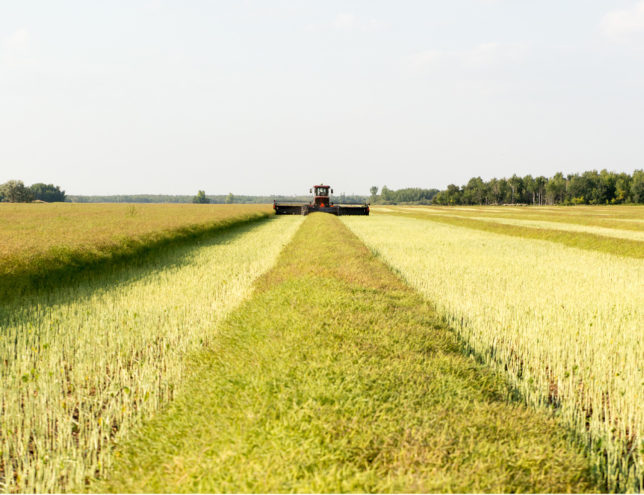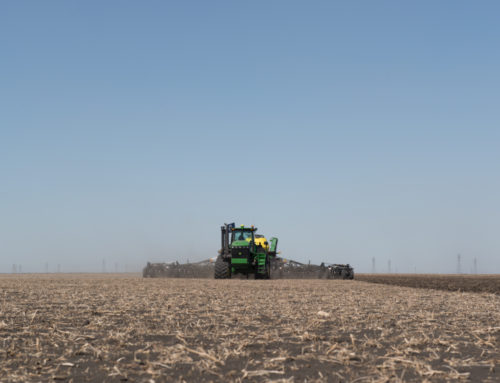The crop is seeded, and depending on where you are, it’s off to a great, good, or middling start. Nonetheless, at some point in the next 4 to 10+ weeks, harvest will happen. Planning for harvest has likely already started – probably even before the seeder hit the field with the crop rotation decisions and choice of variety. Growers are looking to spread the workload and maximize human and equipment efficiencies, by choosing crops and varieties that have different requirements in terms of seeding, in-season management, and harvesting demands.
When it comes to harvest, not all crops are created equally. Cereals, for example. Mitchell Japp, provincial cereal crops specialist with Saskatchewan Agriculture, advises growers to target cereal harvest with safe storage in mind. “While I advise growers to target a safe storage moisture content of 14.5 percent at harvest for wheat, this is not always possible,” he says. “At 16 percent moisture, many growers will decide to go given how much they have to harvest.” If you are combining at higher moisture contents, then be prepared to dry that grain down to a safer level with aeration, or drying. “The later in the fall, the harder it will be to get grain moisture down to safe levels without using a grain dryer.” Not getting cereals harvested in a timely manner if the moisture is too low can lead to broken kernels in wheat, peeling in barley, and shattering in oats. “Of all the cereals, wheat may be the most forgiving in a difficult year,” says Japp.
With canola, there are no key dates according to Sherri Roberts, regional crops specialist with Saskatchewan Agriculture based out of Weyburn. “Depending on whether you are swathing canola or straight cutting it, the key to determining when it’s ready to harvest is seed colour,” says Roberts. “When any crop is swathed, ripening will continue in the swath. We recommend a minimum of 30 to 40 percent seed colour change from green to black as the green light to swath canola if early swathing is needed. A 60 percent colour change is the ideal but harvest timing may not allow for this. In addition, roll seeds within your fingers, and if the seed is mushy, it needs more time to mature.
Straight cutting canola is a relatively new practise that is gaining favour with many growers. It offers numerous benefits, including cutting out one field operation. Growers need to first seed canola hybrids with proven pod shatter tolerance before considering straight cutting, otherwise losses can be significant. “Providing everything is done right, canola is more mature at the time of straight cutting. Harvest as soon as possible after the seed falls below 2 percent green content and is dry enough to store,” says Roberts. “The risk can be not being able to get into the crop at that time for environmental or other reasons; however, some growers are adopting this practise with enthusiasm.”
Lentils are an indeterminate crop type – they will keep on growing. “Harvesting lentils comes down to scheduling,” says Roberts. “They have to be desiccated first and then combining needs to be very timely, as lentils will shatter if left too long.” The time between desiccation and combining is dictated by the desiccant used. Desiccation is recommended when the bottom pods turn yellow/brown and the seeds can be heard rattling. Because lentils shatter easily and the seeds can be damaged if too dry, it’s recommended to combine at 18 percent moisture content.
Finally, soybean is a relatively new and rapidly growing crop on the Prairies making its way inexorably west. “Soybeans are a very interesting crop and can have a great fit on the farm to spread out the harvesting workload,” says Roberts. “They can be desiccated or not. Growers can just wait for Mother Nature’s desiccant – frost – to do the job for them. However, if they have a weedy field, a desiccant will do double duty to dry down the crop and clean up the field.” Soybeans will not shatter out like lentils. “This is what’s really nice about soybeans,” says Roberts. “I saw growers harvesting them last year in November and December.”
There are many balls to juggle when it comes to planning harvest; however, knowing which crops need the kid glove treatment and those that can take a little more wear and tear will help get it all in the bin.







Leave A Comment